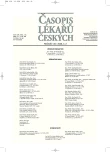-
Medical journals
- Career
Increased Risk of Malignancies in Heterozygotes in Families of Patients with Nijmegen Breakage Syndrome
Authors: E. Seemanová; P. Jarolím 1; P. Seeman 2; R. Varon 3; K. Sperling 3
Authors‘ workplace: Oddělení klinické genetiky, Ústav biologie a lékařské genetiky 2. LF UK, Praha ; Ústav hematologie a krevní transfuze, Praha 1; DNA laboratoř Kliniky dětské neurologie, 2. LF UK a FNM, Praha 2; Institut für Humangenetik der Humboldtuniversität zu Berlin, SRN 3
Published in: Čas. Lék. čes. 2006; 145: 138-143
Category: Original Article
Overview
Background.
The autosomal recessive chromosomal instability and hyperradiosensitivity Nijmegen breakage syndrome (NBS) in consequence of a mutation in the NBS1 gene at 8q21 is associated with high occurrence of lymphoreticular malignancies due to deficient DNA reparation (double strand breaks). In the Slavic population the majority of patients are homozygotes of the so-called “Slavic mutation” 657del5 in exon 6. Increased occurrence of malignant solid tumors (1) in families of NBS patients has been described already prior to the identification of the responsible gene, and the increased risk of malignancies in heterozygotes was thus hypothetical.Methods and Results.
The possibility of discerning mutation carriers in families from normal homozygotes enables verification of that hypothesis. Through molecular genetics investigations of grandparents and immediate relatives, we have been successful in determining the genotype in 79 of 112 grandparents in 28 families of our 39 patients and 54 their parents and siblings. A single family had affected children in consequence of compound heterozygosity of the 657del5 and R215W mutations in the same exon of the NBS1 gene. The proband’s families were investigated genealogically and data on relatives were obtained over four generations. Obtained data were repeatedly supplemented and objectively verified in church books and in healthcare documentation. Seven families have been followed up for 20–30 years, six families for 10–20 years, and 15 families for 1–10 years. Out of 28 families we were successful in examining the genotype of both grandparents in 18 families, there having been revealed one non-paternity; in five families only one genetickéof the grandparents has been examined; in five families we were not successful in examining any grandparent. Among 40 grandparents – normal homozygotes, there has appeared a malignancy in three (7.4 %), while among 39 heterozygotes of mutation 657del5 in the NBS1 gene malignancies were documented in 15 (38,2 %). Mean age of NBS heterozygotes at manifestation of malignancy was 59.3 year (range 47–72 years), in the group of homozygotes it was 52.6 years (range 44–62 years). Nine grandparents died of malignancy prior to the discovery of the NBS1 gene and their genotype has been deduced genealogically in seven on the basis of the genotype in the sponse and children, in two from preserved DNA. Out of that number, from three grandparents that had died of malignancies we were successful in obtaining neoplastic tissue for molecular genetics investigation, aimed at LOH or amplification of the NBS1 gene. In another seven grandparents – heterozygotes, malignancies were manifested after determination of their genotype by DNA analysis, and consequently also from tumor tissue that has been obtained from three of them for molecular genetic investigation.Conclusions.
The age distribution and socio-economic status of both groups of grandparents did not differ, the sex ratio was slightly shifted towards females in the group of homozygotic grandparents (22 females and 18 males), and in the group of heterozygotes it was towards males (21 males and 18 females). The sex ratio between heterozygotic grandparents with malignancies was likewise shifted towards the male gender (11 males and 4 females), in the group of homozygotic grandparents malignancy affected one male and two females. As verified in healthcare and church books documentation, the occurrence of malignancies was significantly more frequent among grandparents heterozygotic for NBS1 mutation than in healthy homozygotes. Among sibs of grandparents and great-grandparents was found significant difference in frequency of malignancies in heterozygotes (5/18 = 27,7 %) and healthy homozygotes (2/36 = 5,5 %), too.Key words:
autosomal recessive heredity; DNA repair disorder, chromosomal instability; hyper-radiosensitivity; genealogy study; frequency of malignancies in NBS heterozygotes and normal homozygotes; 654del5 mutation in NBS1 gene.
Labels
Addictology Allergology and clinical immunology Angiology Audiology Clinical biochemistry Dermatology & STDs Paediatric gastroenterology Paediatric surgery Paediatric cardiology Paediatric neurology Paediatric ENT Paediatric psychiatry Paediatric rheumatology Diabetology Pharmacy Vascular surgery Pain management Dental Hygienist
Article was published inJournal of Czech Physicians

-
All articles in this issue
- Cholesterol, Violence and Suicidality – History of Errors
- HLA-DPB1 Gene Analysis in Haematopoietic Stem Cell Transplantations
- Prenatal Diagnostics of Tuberous Sclerosis Based on Causal Mutation Knowledge
- Analysis of Free Foetal DNA in Maternal Plasma Using STR Loci
- Increased Risk of Malignancies in Heterozygotes in Families of Patients with Nijmegen Breakage Syndrome
- Association of Polymorphic Variants in Endothelin-1 (EDN1) Genes with the Therapy of Patients with Cutaneous T-cell Lymphomas
- Pharmacogenetics of Chronic Heart Failure – Beta Blockers
- Consultation Activity of Two Slovak Centres for Pharmacotherapy During Pregnancy and Lactation
- Recurrent Peripheral Arterial Embolism from Metastatic Lung Choriocarcinoma
- History of Medical Genetics in the Czech Republic
- Hypertrophic Cardiomyopathy
- Frequentational View on the Genome Changes Testing
- New Approaches to Haemophilia Treatment – Recombinant and Transgenic Concentrates, Gene Therapy and Engineered Coagulation Factors
- Psychosomatic Approach in Dermatovenerology
- Journal of Czech Physicians
- Journal archive
- Current issue
- Online only
- About the journal
Most read in this issue- Hypertrophic Cardiomyopathy
- Increased Risk of Malignancies in Heterozygotes in Families of Patients with Nijmegen Breakage Syndrome
- Analysis of Free Foetal DNA in Maternal Plasma Using STR Loci
- History of Medical Genetics in the Czech Republic
Login#ADS_BOTTOM_SCRIPTS#Forgotten passwordEnter the email address that you registered with. We will send you instructions on how to set a new password.
- Career

